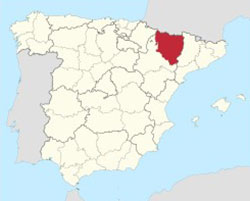Huesca in Huesca

The province of Huesca is one of the three provinces of Aragón in northern Spain. Covering a primarily mountainous surface area of 15,626 km2 it has a population of 219,345 (2018) inhabitants and shares borders with France and the provinces of Lérida, Zaragoza and Navarra.
A large part of the province is in the Pyrenees mountain range, Home to majestic scenery, the tallest mountain in the Pyrenees, the Aneto at 3,404m high; eternal glaciers, such as at Monte Perdido; and the National Park of Ordesa and Monte Perdido, rich in flora and protected fauna. Popular with mountaineers, spelunkers, paragliders, and white water rafters it is also a popular snow skiing destination with notable resorts in Candanchú, Formigal, Astún, Panticosa and Cerler.
The capital of Huesca is Huesca. The city is set at 483 m above sea level; it covers an area of 161.03 km2 and is home to only 52,064 inhabitants, which makes it one of the least populated provincial capitals of Spain. The river Isuela runs through the city.
Average annual temperature is 13°C but in summer the thermometers can be a lot higher and reach up to 35°C or even more nowadays. It snows frequently in winter and the temperatures often go down from -3 to -7°C below zero. The record high was 42.6°C whilst the record low has been -13.2°C. On average, the city has 2,732 hours of sun, 23 days of rain and 35 days of frost.
 The Huesca plateau has been occupied by humans for more than 6,000 years and several flint and ceramic objects have been found in the area. It was also an important Bronze Age settlement, and there are important finds of foundations of fixed dwellings.
The Huesca plateau has been occupied by humans for more than 6,000 years and several flint and ceramic objects have been found in the area. It was also an important Bronze Age settlement, and there are important finds of foundations of fixed dwellings.
The city was once known as Bolskan, in the ancient Iberian language that was used before the Romans arrived, and it was the capital of the Vescetani civilization. During Roman times its name became Osca, and it remained at important city, being the base of Quintus Sertorius, the Roman governor.
The city minted its own coinage and was the site of a prestigious school founded by Sertorius to educate young Iberians in Latin and Roman customs.
Over the 1st to 3rd century, Christianity gradually took hold of Huesca, and in 258 A.D. a Christian native of the city was burned on a grille in Rome and became a martyr and Huesca’s patron saint: San Lorenzo (Saint Lawrence).
When the Roman Empire collapsed in the 5th century, the Visigoths came to town and they in their turn were forced out by the Moors in 719. These changed the name to Wasqa and the city was one of the northernmost cities of the Al-Andalus kingdom.
A mosque was constructed in the 8th to 11th century on the site of the present Huesca Cathedral, the Holy Cathedral of the Transfiguration of the Lord. Today there are very few remains of it, though. As the Christian attacks on the city became more and more frequent during the reconquest. a wall was built around the city. forming a two kilometre long oval. The wall was interspersed by 90 towers.
The Christians on their part constructed a large castle, the Castle of Montearagón, a couple of miles from Wasqa, from where they eventually conquered the city in 1096. The ruin of the castle still stands, but the city walls are long gone. Once under Christian rule, the city prospered and reached a peak of 8,000 inhabitants in the 13th century. However, the plague of 1348 halved the population, and it was not until the beginning of the 20th century that it grew beyond 10,000.
Modem Huesca now counts more than 200,000 souls, and its economy is mainly based on the service sector and tourism. Industry comes a close second, whereas agriculture only contributes with approximately 10% of the city’s income. Tourists visiting Huesca mainly come for the city’s sights such as the cathedral and the Museo de Huesca, situated in the building of the old Universidad de Huesca, which no longer exists.


